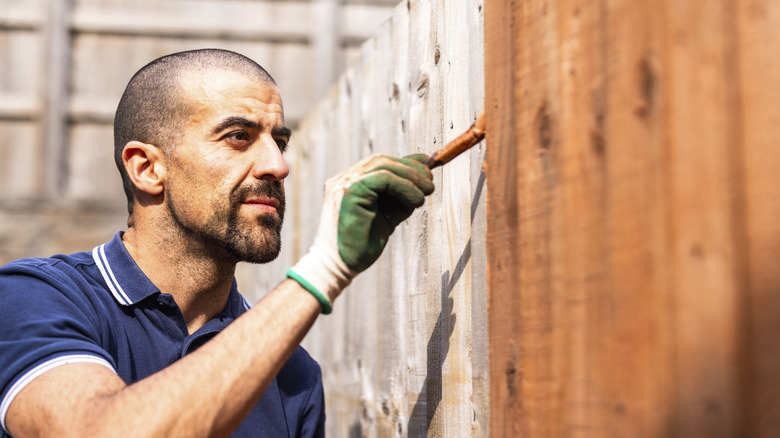Can You Paint Your Side Of Your Neighbor's Fence? Here's What To Know.
The line "good fences make good neighbors" can in fact be, as the Frost poem suggests, a point of contention. Particularly when it comes to agreeing on how to paint it. Despite being a great way to create more privacy in your backyard, without a firm agreement in place, fences can easily become a point of bickering. In extreme cases, they can even inspire legal disputes.
When it comes to painting a fence on the line between two properties (also known as a partition or boundary fence), both neighbors have a say in painting their side of the fence. If you know that the fence lies fully on your neighbor's property, however, you may be in a tight spot. Check local laws first because they can vary, but a fence on your neighbor's property requires their permission to paint even if one side of it faces your home. Painting parts of the fence on your neighbor's property without their permission can be considered vandalism or encroachment (an unauthorized use of their property).
In all cases, it's very important to keep open communication lines with your neighbor if you're planning to make any significant changes to the fence, so you'll remain good neighbors. Of course what you'll do depends on whether you've chosen wood or composite fencing. Disagreements can quickly escalate into boundary-line disputes. Instead, take the time to let your neighbor know your intentions, share your paint or staining ideas, and consider hiring a professional, particularly if it's a big job.
Painting Etiquette to Avoid Neighbor Conflicts
As mentioned earlier, communication will be your friend when negotiating to paint your side of your neighbor's fence. If your neighbor is hesitant about price or effort, emphasize that you will paint it yourself and cover any costs. You could also consider allowing their input on color or style if they are concerned about how it will affect their property. If painting still isn't an attractive option to your neighbor, a compromise may be in order. Wood stains or varnish can freshen a fence's look without altering it as much as paint.
Try to get any plans you make with your neighbor in writing. Conversations are a great start for brainstorming ideas and checking how your neighbor feels about any renovations. But even if you have a healthy relationship with your neighbor, written agreements can help prevent or settle disputes as they arise. Plus, some state or local laws require a written agreement between neighbors before constructing or renovating a fence.
Suppose your neighbor won't budge on a compromise, and you truly dislike how they care for their fence. Even then, you're not out of luck. There are plenty of ways to hide a neighbor's unsightly fence, like installing a second fence on your own property, growing climbing vines, or rearranging your patio furniture.

